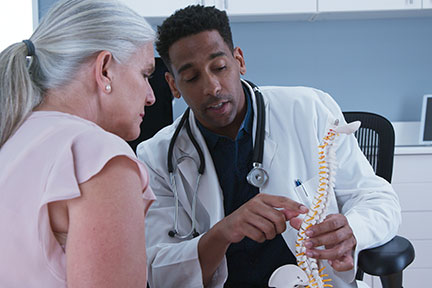
Back pain is a common complaint among working adults. Workers from both an office setting and a labor-intensive industry can experience back pain all the same. Work, productivity, and even family time can be affected. While back problems can affect individuals of any age, older adults are more at risk due to various degenerative conditions.
The spine is made up of 24 individual bones, joints, muscles, discs, nerves, and other parts that work together to support posture and movement. However, when any of these parts malfunction due to various factors, back pain ensues.
Here are the most common back pain triggers among the older population:
- Degenerative Disc Disease: The discs located in between the spinal bones act as “shock absorbers” between your spine’s vertebrae. However, they shrink or tear over time, causing the bones to rub against each other and cause back pain.
- Spinal Stenosis: This condition refers to a narrowed spinal canal and is most common in persons over 60 years of age. Because of this, the nerves that run through your spine become pinched, leading to a painful sensation.
- Spondylolisthesis: This occurs when one of the bones in your spine slips out of place and goes to the bone beneath it. A person may not feel any symptom during its early stages, but back pain eventually catches up with age.

- Osteoarthritis: This is the most common form of arthritis, and it usually affects persons who are over 50 years of age. This happens when your cartilage and bones break down due to age. While it can affect any joint in the body, it also affects the hips and spine.
- Degenerative arthritis: Also called facet joint osteoarthritis, or osteoarthritis of the spine, this back pain-causing condition develops over time and is mainly set off by damaged cartilage between the facet joints of the spine.
- Herniated or Slipped Discs: When the soft tissue in the discs between your joints has slipped out of place, you have a slipped or herniated disc. Slipped discs occur over time, and gets worse as a patient gets older.
- Sacroiliitis: The sacroiliac joint lies where the spine and pelvis meet. Its main function is to properly distribute the load from the upper body towards the lower body. It becomes inflamed because of arthritis, although pregnancy and infection, may likely be the culprit too.
- Sciatica: This condition refers to a radiating or shooting pain that runs along the sciatic nerve, from the lower back to the hips and buttocks. Often, a herniated disk or an abnormal bone growth can trigger Sciatica.
- Osteoporotic Fracture: Seniors are prone to developing osteoporosis because of the continuing reduction in bone mass and strength. With the bones suffering from a weakened state, the chances of having a non-traumatic osteoporotic fracture of the spine increases. The pain is typically abrupt and severe.
Conclusion
There’s no surefire way of stopping age-related back pain, but an elderly person can manage it naturally by becoming more active, practicing yoga, or taking non-steroidal anti-inflammatory medications. Seniors can also use products that can assist in correcting posture and supporting the back to prevent pain. They can consult their health-care providers for the best post correctors for their needs.
 Author: Karina Hatfield
Author: Karina Hatfield
Karina Hatfield is a full-time blogger who regularly publishes articles on health and wellness. Karina also uses her blog as a platform for readers to know more about aging and senior living.
Aside from regularly updating her blog, Karina also submits guest posts to other websites and blogs.
